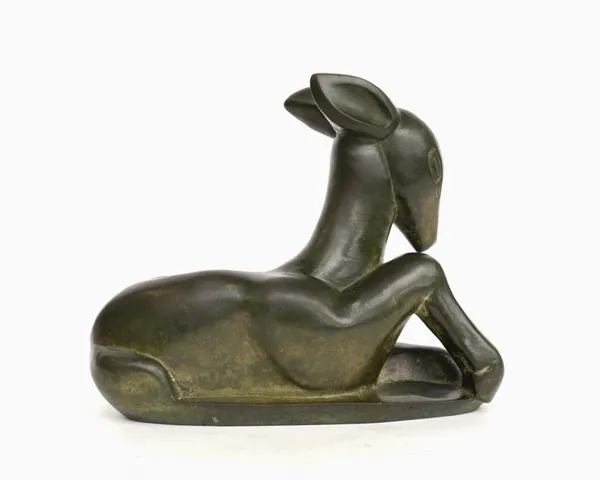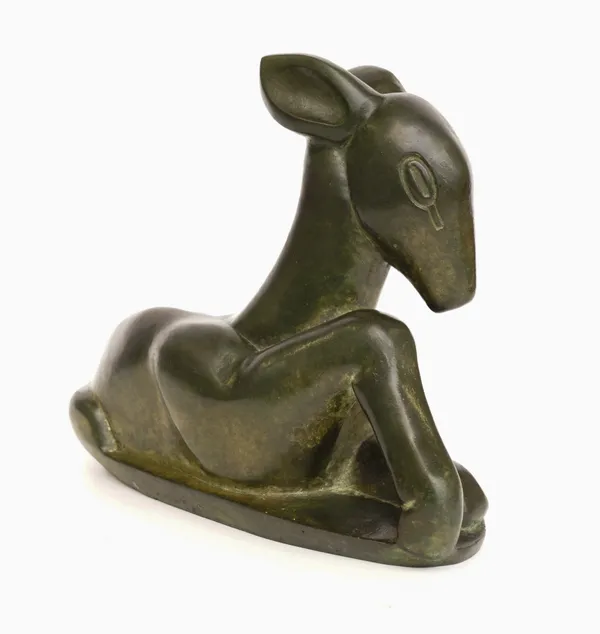Lot 51 Please note this lot is subject to ARR (artist resale rights)
Lot 148 Please note this lot is subject to ARR (artist resale rights)
HENRI GAUDIER-BRZESKA (FRENCH, 1891-1915)
Crouching Fawn
originally conceived in 1913; cast circa 1918-1939
bronze
24.5cm high x 30cm wide x 13cm deep
Provenance
Miss Jeanne Courtauld (1909-2003), daughter of Major John 'Jack' Courtauld MC (MP for Chichester 1924-1942) and the niece of Samuel Courtauld, founder of The Courtauld Institute of Art in London;
Gifted to Faye White by Miss Jeanne Courtauld, thence by descent
| Estimate: | £8,000 - £12,000 |
| Hammer price: | £26,000 |
Literature
E. Pound, Gaudier Brzeska. A Memoir, London and New York, 1916,
p. 161, (stone version pl. ix), as A Faun, crouching;
H.S. Ede, A Life of Gaudier-Brzeska,
London, 1930, p.p. 170, 198 (stone version pl. xxvi as ‘Seated Fawn’);
H. Brodzky, Henri Gaudier-Brzeska,
London, 1932, pp. 176, 182;
R. Cole, Burning to Speak: The Life and
Art of Henri Gaudier-Brzeska, Oxford, 1978, pp. 91, 100, no. 48, as
'Fawn Crouching';
J. Collins, The
Omega Workshops, 1983, p. 70;
E. Silber, Gaudier-Brzeska: Life and Art,
with a Catalogue Raisonne, London, 1996, pp. 42, 98, 121, 130, 265, no. 62;
Footnote
Crouching Fawn was originally carved by Gaudier in 1913 in Bath stone. He is
known to have observed deer in Richmond Park and it is thought that they
provided his inspiration for Crouching Fawn, the original carving having
evolved from his many animal drawings, some of which have been described as
being in the ‘Chinese Manner’. Gaudier had become an associate of the Omega
Workshops and had Crouching Fawn exhibited in 1914 as part of the Grafton
Group's exhibition at the Alpine Club Gallery, being sold to a Mrs Mayor. It
was subsequently lent by Mrs Mayor for the Gaudier-Brzeska 1918 Memorial
Exhibition at The Leicester Galleries, London, following the artist's death in
the First World War in 1915. In 1931 it was exhibited again, this time
featuring as part of an exhibition of Gaudier-Brzeska's work held by J & E
Bumpus in London. Remaining in the same family, it was over sixty years until
it appeared on public display once more, when Mrs Mayor's carving was lent to
Birmingham Museums and Art Gallery in 1993. Having remained in the same family
since Mrs Mayor's acquisition in 1914 the carving was sold at Christie's,
London, in 2007 (20th Century British Art, 16th November 2007, lot 142) and is
now understood to be in a private collection.
The
painted plaster cast of Crouching Fawn is in the Tate (T03729). It is not known
when exactly this was created but it is thought to have been acquired by The
Leicester Galleries sometime after 1918 and then presented to the Victoria
& Albert Museum by them in 1939, with a relative of Mrs Mayor (probably a
Rothschild) attesting that it was cast in the 1920s. It is thought that the
plaster cast might have been used by The Leicester Galleries as a 'shop sample'
from which clients could commission bronze casts. In 1983 this was transferred from
the Victoria & Albert Museum to the Tate.
Roger
Cole, in Burning to
Speak: The Life and Art of Henri Gaudier-Brzeska, suggests there were twelve bronze casts but the exact
number is not known. A cast formerly in the collection of Maynard Keynes and
subsequently owned by Lincoln Kirstein was offered at Christie’s on 10th
November 1989, lot 411. The catalogue asserts, presumably based on the Cole
literature, that the Leicester Galleries had twelve bronze casts made between
1918-1939 before presenting the plaster cast to the Victoria & Albert
Museum. A bronze cast was with The Fine Art Society in 2016/17, which is
likely to be the same work offered at Christie's in 1989, as the provenance
lists Mina Kirstein Curtiss, brother of Lincoln Kirstein, both friends of Mr
and Mrs Maynard Keynes. There is also a bronze cast (HGB 7) (catalogued as Seated Fawn) in the collection of Kettle's Yard, University of Cambridge.
Jeanne Courtauld lived at Cookes House, near Pulborough, West Sussex, part of the contents of which was sold by Strides Auctioneers, Chichester, in 2003, and
contained many items her father had collected.
Faye White was Jeanne Courtauld's housekeeper for over ten years and became a close friend and dear companion, looking after her through the good years and in her worsening health until her death in 2003.
We are grateful to Dr Evelyn Silber for her assistance with the cataloguing of
this work.
Please note the original letter from Sir Adam Butler to Faye White is not included in the sale.
Condition report
Attractive deep green patination with attractive tonal contrast to lower part of body on reverse.
Some casting imperfections including some bronze fillings can be seen inside underneath, see image of underside inside. These cannot be seen on the outside.
Appears in overall generally good original condition.








